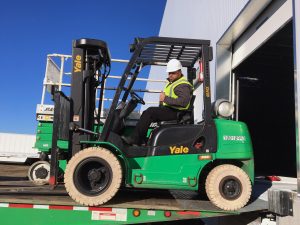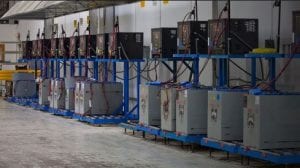As more states move to phase out internal combustion (IC) forklifts—those powered by LPG, gasoline, or diesel—to electric models, it’s important to consider more than just the change in power source. This shift impacts various areas of your business, including operations, finances, and infrastructure. However, switching from IC to electric can bring significant advantages, such as lower operating costs, a reduced environmental footprint, and decreased maintenance. These steps will help you navigate the path to electrification.
Six Key Considerations when Switching from IC to Electric Forklifts:
Assessing Operational Requirements
- Load Capacity and Performance: Ensure that the electric forklifts you are considering can meet or exceed the load capacity, lift height, and performance levels of your current IC forklifts. While electric forklifts can go up to 15,000 lbs. in some applications, you should consult a forklift expert to determine other options, particularly for heavy-duty or high-lift applications.
- Shift Duration: Electric forklifts typically run on batteries that need to be recharged after a certain number of operating hours (usually 6-8 hours). For operations requiring continuous use, such as multiple shifts, ensure you have the necessary charging infrastructure and consider options like battery swapping or fast charging systems. Abel Womack can perform a detailed time study of your IC or electric equipment to help determine the most efficient and cost-effective power solution for your operation. The study provides a comparative analysis between lead acid, NexSys Thin Plate Pure Lead (TPPL), lithium or hydrogen fuel cell and allows you to make a well-informed decision.
Cost Considerations
- Initial Investment: Electric forklifts tend to have a higher upfront cost than IC forklifts. This is due
 to the price of the battery and charger, and the advanced technology of electric powertrains. However, the total cost of ownership over the long term is lower due to reduced fuel and maintenance costs. (use this free cost comparison tool: Switching from IC to Electric Calculator)
to the price of the battery and charger, and the advanced technology of electric powertrains. However, the total cost of ownership over the long term is lower due to reduced fuel and maintenance costs. (use this free cost comparison tool: Switching from IC to Electric Calculator) - Operating Costs: Electricity is generally less expensive than fuel (LPG, gasoline, or diesel). Electric forklifts have fewer moving parts and don’t require fuel filters, oil changes, or exhaust systems. This results in lower maintenance and repair costs. Additionally, there is no engine or transmission on electric forklifts, further lowering the total cost of ownership.
- Charging Infrastructure: Installing charging stations for electric forklifts requires an upfront investment. Costs may include installing adequate electrical outlets, charging stations, and possibly upgrading your facility’s electrical system. Consult with your forklift dealer early to ensure your power needs are covered and avoid costly upgrades later.
- Battery Storage: Consider how to store spare batteries or manage battery-swapping systems. Lead-acid batteries require periodic checks for water levels and need to be stored in a cool, dry place unlike electric battery types that don’t require battery swapping.
- Charging Stations: Determine the number and placement of charging stations based on your fleet size, battery type, charger specifications, and usage patterns. For large fleets using lead-acid batteries, you’ll need a dedicated, well-ventilated charging room to accommodate multiple stations safely as these batteries emit gases during charging and require regular maintenance. In contrast, newer technologies like lithium-ion and hydrogen fuel cells charge faster, require less maintenance, and don’t need special ventilation, offering greater flexibility in station location and layout. This can free up valuable floor space.
- Battery Types: The most common battery types for electric forklifts:
- Lead-acid: These are less expensive but have a shorter lifespan and require regular maintenance, such as water refilling.
- Lithium-ion: Delivers the best performance for multi-shift environments with fast charging, requires zero maintenance, but are more expensive upfront.
- NexSys TPPL: Offers fast charging, long cycle life, and maintenance-free operation for light to medium applications. No battery watering or charging required.
- Hydrogen Fuel Cell: Ideal for high-utilization fleets needing rapid refueling and zero emissions, outperforming lithium-ion in uptime for large operations but requiring significant infrastructure investment.
- Battery Life and Replacement: Batteries degrade over time, so you’ll need to plan for periodic battery replacement, particularly if you’re using lead-acid batteries. Evaluate all power option warranties to understand the estimated life of each and how the costs relate.
- Battery Maintenance: Proper battery management and charging habits are crucial for maximizing battery life. Most modern electric forklifts have integrated battery management systems to monitor and optimize battery performance. Some dealers can recommend or set up maintenance to fulfill requirements to maintain the warranty and longevity of your batteries.
Environmental Impact
- Emissions Reduction: Electric forklifts produce zero direct emissions, unlike IC forklifts that emit CO2 and other pollutants. This makes electric trucks an excellent choice for indoor environments, particularly those with strict environmental or health regulations.
- Green initiatives: In the U.S. there are several focused on reducing the environmental impact of forklifts, specifically IC trucks. The California Air Resource Board is leading the charge, requiring all new forklift purchases to be zero-emission starting in 2026. Several other states, including New York, are considering similar standards. In addition, state-level programs offer rebates and grants to help businesses replace IC trucks with electric or hydrogen-powered forklifts. Major companies like Amazon and Walmart are already transitioning their fleets to meet their corporate sustainability goals. While businesses pursuing LEED certification are adopting clean forklift technologies to reduce carbon emissions.
- Noise Reduction: Electric forklifts operate more quietly than IC forklifts. This reduces noise pollution in your facility and creates a safer and more comfortable working environment.
- Energy Source: The environmental benefit of switching from IC to electric forklifts also depends on the source of the electricity used to charge the trucks. If your electricity comes from renewable sources, your environmental impact is much lower than using electricity from fossil fuels.
Safety Considerations
- Battery Hazards: IC trucks require diesel, gas or LPG. These are flammable, and require regular watering, which can lead to acid spills. Maintenance-free batteries are sealed and eliminate the need for fuel storage and potential chemical accidents. While electric forklifts don’t use flammable fuel, the batteries can pose risks like thermal runaway, especially with lithium-ion batteries. Ensure you have adequate safety protocols for charging and maintaining batteries.
- Ventilation: With electric forklifts, there’s no need to worry about exhaust gases. For lead-acid battery systems, proper ventilation is still required in the charging area to avoid build-up of hydrogen gas.
- EH&S: Your safety specialists minimize this risk by developing and enforcing safety protocols.
Tax Incentives and Grants
- Government Incentives: In some regions, businesses switching from IC to electric forklifts may qualify for tax incentives, rebates, or grants for utility and government programs promoting environmental sustainability. Abel Womack can assist with local incentives available.
Paving the Road to Electric
Switching from IC to electric forklifts is more than a trend—it’s a strategic investment in efficiency, sustainability, and long-term cost savings. By carefully evaluating your operational needs and planning ahead, your operation can make a smooth transition and be better positioned for the future. Take the next step. Contact your local material handling provider to get the conversation started.




Leave a Reply
You must be logged in to post a comment.